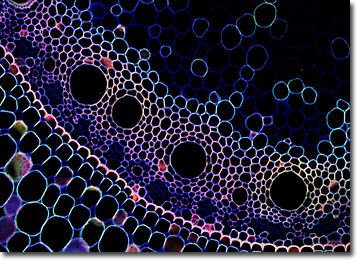 |
 |
 |
|
||||||||||||||||||||||||
 | ||||||||||||||||||||||||
 | ||||||||||||||||||||||||
 | ||||||||||||||||||||||||
Confocal Microscopy Image Gallery
Plant Tissue Autofluorescence Gallery
Corn Prop Root
The roots of a plant function in many different ways, including absorbing nutrients and water, providing anchorage, and acting as a food storage site. A special type of root called a prop root also plays a substantial role in endowing certain plants with extra structural support.

Prop roots do not grow from the embryo of a plant, but are rather secondary roots that develop from the tissues of other structures. These and other roots that are produced by stems or leaves are termed adventitious. Plants with prop roots often have very tall or branching stems that could be easily blown over by strong winds if not adequately propped up or are native to areas where the ground is particularly soft and unstable. Overall they are more common in tropical habitats than in temperate zones.
The corn plant, Zea mays, is a cereal grass native to the Americas that has been cultivated for thousands of years. The stem of the plant is very tall and is usually supported by numerous prop roots that can be seen extending out from the stemís base. Similar to other monocots, the primary root system of the corn plant is poorly developed and is inadequate to serve as a sufficient foundation for its growth. As a result, adventitious roots arise early in the plantís development and branch into a relatively shallow, fibrous root system in the areas they come into contact with the soil. The extensive secondary system buttresses the plant stem and obtains all of the water and nutrients necessary for plant growth.
Contributing Authors
Nathan S. Claxton, Shannon H. Neaves, and Michael W. Davidson - National High Magnetic Field Laboratory, 1800 East Paul Dirac Dr., The Florida State University, Tallahassee, Florida, 32310.
